Field Herping Methods
Flipping | Road
Cruising | Time of Year | Phase
of the Moon
CAUTION: The methods
described here are usually considered "hunting" by
governmental agencies, and necessitate the possession of the
appropriate licenses--EVEN IF YOU DO NOT KEEP WHAT YOU FIND.
Consult my Laws & Equipment page for
details.
This technique entails finding likely sites and turning over,
or "flipping," ground cover to find reptiles.
There are two basic types of cover encountered: natural and
artificial.
Natural cover includes rocks and logs, or basically anything in
the natural environment which could conceivably provide shelter
for herps. Artificial cover can be deliberate or
unintentional. Examples of deliberate artificial cover
include large sheets of plywood and tin which are set out for the
specific purpose of attracting herps and providing suitable
microhabitats for them. Unintentional artificial cover is
everything else humans produce which ends up in the
environment. In other words, our trash can often provide
suitable, even preferred, habitat for herps. The photo at
right shows a gorgeous juvenile (~15") California
kingsnake, as it was found, resting beneath a piece of
plywood.
Trash dumps are usually outstanding sites to look for herps.
The "official" dump sites authorized by various
governmental agencies are typically not as good, however, since
they're organized and separated by type of trash, and maintained
in fairly sanitary (from an environmental standpoint)
conditions. The "illegal dump sites" are actually
better for flipping. Such sites are in better locations (out
in the woods, off less-traveled roads) and contain a wide variety
of suitable material--from boards and railroad ties to old chairs,
carpet, and mattresses. THIS is the type of dump site which
usually pays off.
|
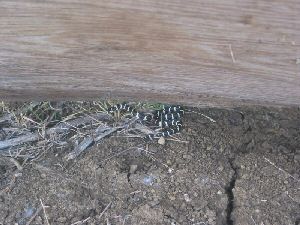 |
| Ironically, local
organizations which claim to be environmentally-minded are often
employed to clean up such favorable sites because of the aesthetic
factor--illegal dump sites are an eyesore, and while many (if not
most) types of trash shouldn't be "out in the wilds,"
large pieces of sheet metal (old highway signs) and lumber
(plywood) should be left. In many areas, these items can
blend in with the surroundings to the point where they are not
noticed by the casual observer (vegetation conceals it, for
example, and plywood weathers well). Organizations involved
in such "environmental causes" often encounter many
types of animals during the course of their cleanup efforts,
including snakes, salamanders, field mice, etc. which they have
just rendered homeless by the removal of artificial cover.
The photo at right shows me flipping a piece of plywood which
is barely noticeable. The next picture shows what was
underneath.
|
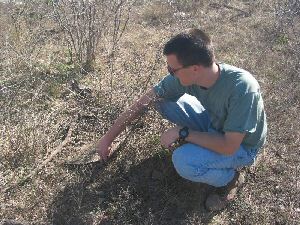 |
| A small western
diamondback rattlesnake was found underneath the
plywood. The casual outdoorsman would probably walk right
past the well-concealed plywood without noticing it.
However, there can be several snakes hiding under a piece of wood
that size.
|
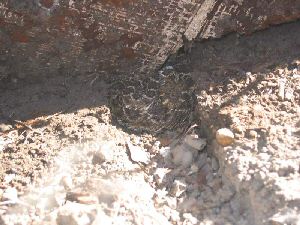 |
| Much as manmade
impoundments are often managed for sustainable take of various
types of fish, areas can be provided with artificial cover
(setting "board lines," as it's called when laying out
numerous pieces of plywood in an area) which will provide greater
habitat not only for herps, but for many of their prey items as
well. I personally know of people who have managed such
board lines and were able to collect numerous snakes from each
such area year after year, and I've experienced the productivity
of such board lines firsthand.
|
|
| Flipping usually
involves being "out in nature" (who would've guessed?),
but the unforeseen consequences can be chiggers, ticks, poison
ivy, etc., even snakebite. To counter this, most field
herpers wear long pants and boots. Depending on the location
and vegetation type, I sometimes get by with just shorts and
sandals (this works better in the Southwest than in grassland-type
areas). Another growing concern is fire ants. These
ants like to build their colonies under cover, and I've flipped
numerous boards and tin sheets which contained thousands of these
stinging insects. Pay close attention not only to what's
under the flipped item, but to the part you're holding on to--it
can be covered in ants, which will soon cover your hand!
|
|
| A long flipping session
can wreak havoc on your hands, given the rough consistency of
rocks, boards, and other cover. Gloves are recommended
(though I usually forget mine!). Some people prefer to not
touch the cover itself at all, instead using a field hook or even
a potato rake. This technique usually works better with two
people--one to do the lifting with the implement (easiest to
accomplish from the opposite side from the one you want to lift),
and one to look under the lifted object for any herps.
The photo at right depicts the two-person technique. A
friend used his potato rake to first lift the wooden pallet,
then used it to brace the pallet in position while I examined the diamondback
resting underneath.
|
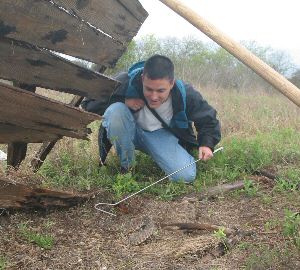 |
| Finally, pay close
attention to how the cover rests on the surface. It will
usually be slightly sunken into the soil, and this creates what is
called a "moisture seal." The relative
impermeability of this seal helps to maintain the microhabitat
under the cover slightly more humid than ambient conditions, and
is often the determining factor in its selection by herps to use
for their activities. Take extra care to replace the cover
exactly as you found it--it will often fit back into its original
position like a puzzle piece. By doing so, you guarantee the
cover will remain attractive for use by herps. There are
many unethical people out there who leave a path of destruction in
their wake, with cover turned but not replaced.
back to top
|
|
|
Road cruising involves driving suitable roads which traverse
suitable habitat, looking for herps on or near the roads.
Depending on target species and climatic conditions, this can be a
productive means of observing and/or collecting herps. On
the other hand, under marginal conditions, it can be very time-
and fuel-consuming!
Suitable roads are those which do not receive a lot of
traffic. For example, a two-lane county road is usually
better than an interstate highway. I don't say this because
the herps prefer one type of road over the other, but rather
because the act of road cruising typically entails driving slower
than speeds expected on major thoroughfares. Additionally,
it is sometimes necessary to stop and turn around to get back to a
herp, and this is difficult to impossible on most well-traveled
roads. I view this as a safety issue and don't plan to
cruise such roads.
I like to joke that the speed at which to road-cruise varies in
direct proportion to the time elapsed since the last animal was
seen. By that I mean that at the start of my cruise, I drive
very slow--15 miles per hour or so. If I don't see anything
for a while, I tend to drive faster and faster. Finally,
I'll be doing 40 and THAT'S when I come across a big snake in the
road! After stopping to photograph it and move it off the
road, I'll revert to the 15 mph speed and hope I'll see another
snake soon. This process repeats until the cruise is
finished. I'm not saying that's the preferred technique,
just how it ends up a lot of the time.
|
 |
| As far as the best
speed is concerned, that will be for the individual herper to
determine. My eyes aren't the best in the world, so I tend
to drive a little slower--usually 15-25 mph. It also makes a
difference what kind of herp you're anticipating. Smaller
species such as shovelnose snakes
and geckos usually dictate slower
speeds, though I know people who can reliably spot these driving
55 mph. Regardless, this is another reason you don't want to
cruise major roads--you do not want to drive at a speed that
impedes normal traffic flow; that could get you a traffic ticket.
The flip side of this is driving too quickly. Night
driving can be hazardous if done incorrectly--don't
"overdrive your headlights;" that is, ensure you can
stop in the distance illuminated by your headlights. This
reduces the potential for hitting objects in the road, whether
they're snakes, pieces of blown tires, cows, or even kangaroos
(click on the link at right for an example--this happened to me in
Northern Territory, Australia).
Spotting animals on the road gets easier with experience.
You will initially be stopping for a lot of rocks and twigs in the
road until you get a mental picture of how a snake is going to
look on the road in your headlights. Snakes will usually
show up very pale against a blacktop road.
|
Link
to QuickTime Movie |
| Road cruising can be
effective both day and night. I tend more towards night
cruising, looking for snakes and nocturnal lizards which use the
road surface for warmth. Asphalt roads work best for night
cruising in my experience, primarily because these roads retain
heat well (which is desirable for poikilothermic animals like
herps) and because herps are generally easier to see against the
dark surface. Some herpers cruise gravel and dirt roads, but
these are usually more productive during the day than at
night. In addition, it's often harder to discern a snake on
these roads--ruts and "washboarding" on gravel roads can
cast convincing shadows in a car's headlights which are easily
mistaken for snake by the novice herper.
The picture at right shows a Stimson's
python in Australia.
Notice the snake is very bright in the headlights. The dark
area in the center of the snake's body is from a shadow cast by my
lantern/flashlight.
Different times of day and times of year are effective for
different species. Herps can be found at all times of the
day, but the nocturnal types seem to come out in force about an
hour after local sunset. However, I've found herps through
midnight, and some nocturnal herps will continue to be active
through sunrise.
back to top
|
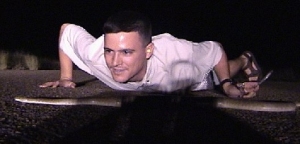 |
|
Most herps in temperate climates are relatively inactive during
the winter months, though I've had success flipping in January and
February. Typically, however, herps are brumating at this
time and therefore are deeper underground. As spring arrives
and ambient temperatures slowly climb, these herps move towards
shallower hideouts, including surface cover. This time of
year (February-April) is usually productive for flipping.
The animals will utilize cover to increase their body temperature
without exposing themselves to predators. Rocks and sheets
of tin are especially attractive since these materials absorb a
lot of thermal energy and retain it even after sunset. You
probably noticed I'm wearing a coat in one of the pictures
above. That's because it was a cold March morning when we
found the diamondbacks. Also, the baby California kingsnake
was found in January!
Herps will start foraging and looking for mates as the
temperatures continue to climb. This means cover is used
less, and road cruising increases in productivity. The
warmer it gets, the less activity will be noticeable on roads
during the daytime, and the nocturnal herps will begin to be more
prevalent. March through June is a general time frame when
road-cruising is productive.
In the middle of summer, it is often difficult to find many
herps, as they will often retreat to their deeper sites to escape
oppressive heat and low humidity on the surface. Rain
showers greatly increase the odds of finding the animals during
road-cruising episodes.
The entire process tends to reverse in late summer through
fall, and tapers off with the onset of winter. Keep in mind
these are just general guidelines, and the optimum seasons for
various herping activities usually overlap considerably, with both
primary methods being effective simultaneously under optimum
conditions.
back to top
|
|
|
Much is made of the phase of the moon, especially when herping
at night. The conventional wisdom, as well as the experience
of many, dictates that herps are not as active when there is a
good chance of predators being able to see them, i.e. in full-moon
situations. Therefore, many people plan their herping trips
around the new moon.
However, just because there's a full moon on the calendar
doesn't spell disaster for a herping trip. Overcast clouds
can obscure the moon. Also, check the moonrise/moonset
times. It doesn't matter if there's a full moon on your
scheduled adventure is the moon is out during the day!
The bottom line is that the animals will move when they feel
like it--we haven't unlocked all their secrets.
back to top
|
|
|
|
|
|
|
|
|